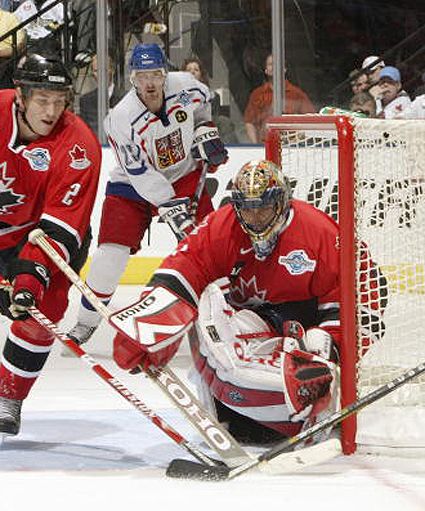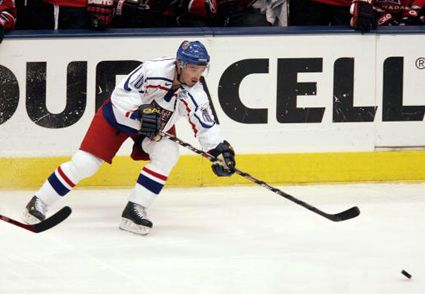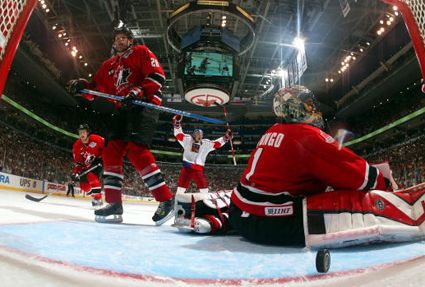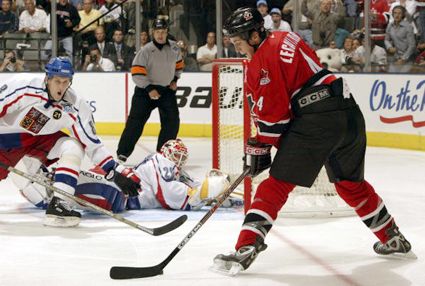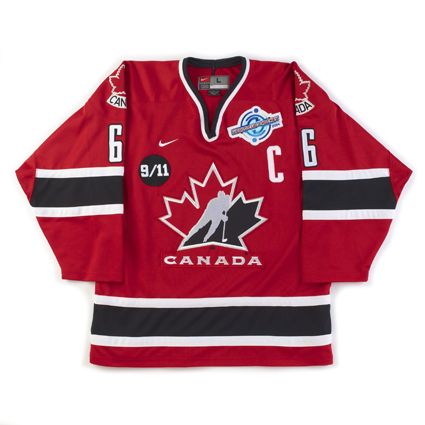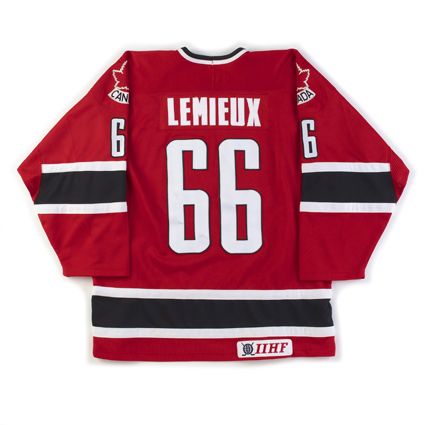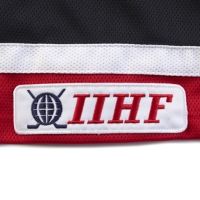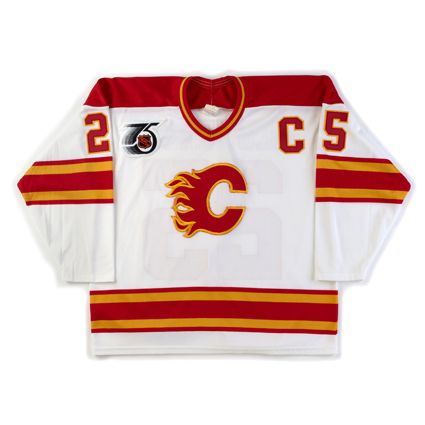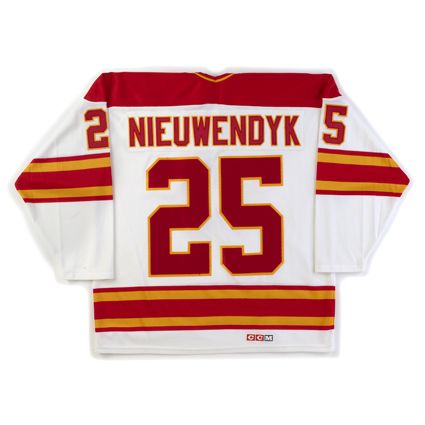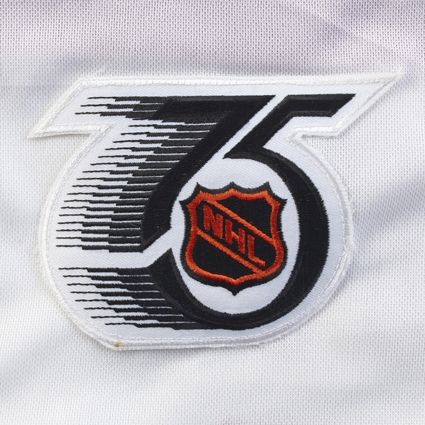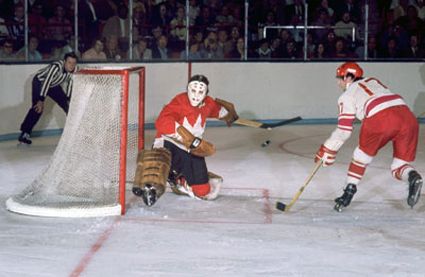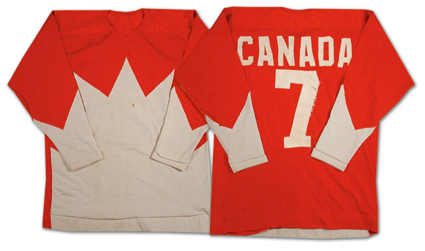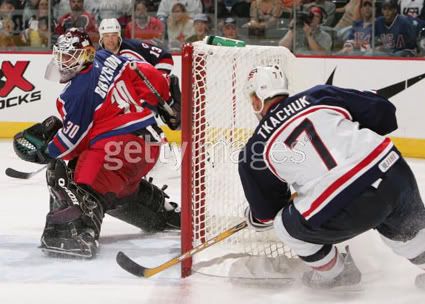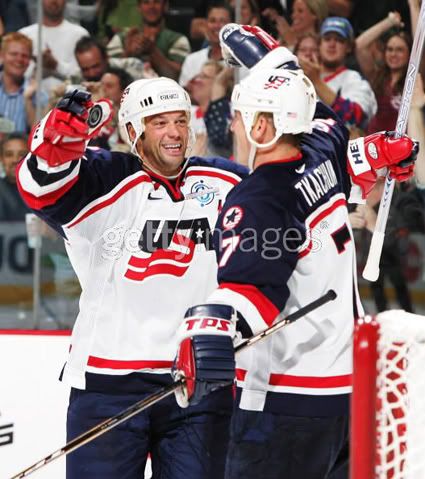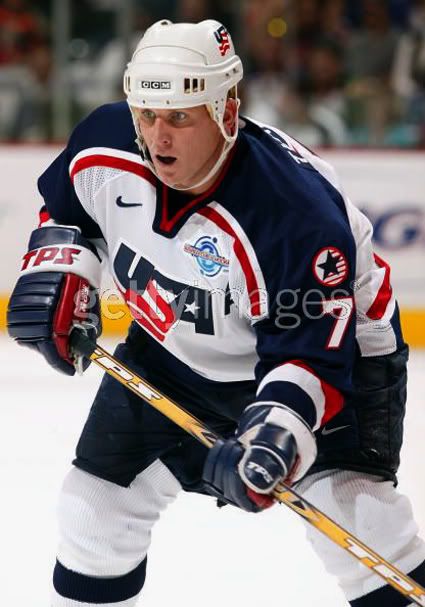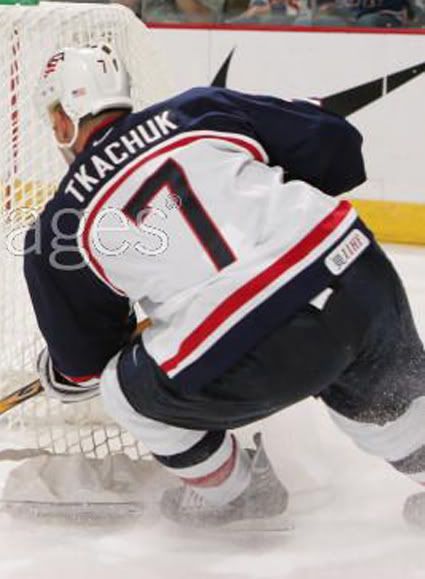Saturday, September 12, 2009
Hockey Jersey Numbers
On this day in 1940, the NHL board of Governors eliminated the requirement that only jersey numbers 1-19 be allowed to designate players in NHL games.
This opened up a can of worms that I'm not sure the Board of Governors anticipated at the time. Traditionally, goaltenders always wore #1, while the defensemen commonly wore numbers 2 through 6, a tradition that continues to this day.
When I was young, goalies always seemed to wear #30 or #35 and numbers such as Don Beaupre's #33, Ken Dryden's #29 or Gilles Meloche's #27 were out of the ordinary.
I don't recall any regular skaters wearing anything higher than #29 when I was a kid. Then I became aware of fringe players wearing numbers in the 30's, which looked odd to me.
And then came the Phil Esposito trade to the New York Rangers in 1975. Esposito wore #7 with the Bruins, but when he arrived in Manhattan, #7 was already being worn by veteran Rod Gilbert, and Esposito doubled his #7 and became #77, while Ken Hodge did the same and became #88. There certainly may have been earlier examples of unusually high numbers, but for my then 13 year old mind, it was the first time I was aware of numbers over 35 for anyone.
Then came Wayne Gretzky...
#99 was so far out of the norm and seemed to open the floodgates for "football numbers" in my teenaged recollection.
Brian Lawton followed with the unfortunate choice of #98, which would prove impossible to live up to due to it's implied expectations of being so close to Gretzky's #99. Mario Lemieux arrived bearing #66. Eric Lindros made #88 famous. Steve Heinze donned #57. Certain players found their preferred number taken and swapped digits leading to even more numbers which would be more at home on a linebacker than a goaltender. Ron Hextall's #27 was in use on Long Island, and he began to wear #72.
Speaking of goaltenders, Domink Hasek and his unconventional #39 has influenced a generation (or two) of goalies who now wear #39, such as the Islanders Rick DiPietro. Or does he wear that because that's the number of years of his contract? I can't remember...
Now high numbers are obviously here to stay, especially when young stars such as Rick Nash (#61), Phil Kessel (#81) and of course, Sidney Crosby and his #87 came into the league wearing high digits and making them their own right from the start, than switching to them mid-career for various reasons like Esposito, Hodge, Hextall and Ray Bourque all did.
The storied and traditional Montreal Canadiens have now retired so many numbers that the players have little choice in the matter. With 1, 2, 3, 4, 5, 7, 9, 10, 12, 16, 18, 19, 23, 29 & 33 all out of circulation, the Canadiens last season featured a roster with decidedly un-traditional numbers such as 40, 41, 44, 46, 51, 53, 67, 68, 70, 71, 74, 79, 80 & 84 - 14 out of 33 players wearing #40 and above.
Compare that to the 1967-68 team, during the first year of expansion, when the highest number on the team was goaltender Rogie Vachon at #30 and no skater wore anything higher than #26.
Jump ahead another 10 years to 1977-78 and Rod Schutt with #30 and Pat Hughes with #31 were the only skaters out of the 20's. Ten more years shows the trend creeping upwards, thanks in part to the influence of Gretzky who arrived in the NHL in 1979. The 1987-88 Canadiens now had John Kordic #31, Claude Lemieux #32, Mike McPhee #35, Sergio Momesso #36, Mike Lalor #38, Brian Skrudland #39, Vincent Riendeau #40 and Stephane Richer #44 on the roster for a total of 8 "high numbers", but you will note they are all still under 50.
1997-98 shows #34, #37, #38, goalie #41, #43, #44, #46, #48, #49, #51, #52, #55 & #71 for 13 high numbers and seven of those higher than any seen in 1988, which brings us to today with the "football numbers" in the 40's, 50's, 60's, 70's & 80's now being commonplace.
One oddity that we recall was the Vancouver Canucks of 2005-06, with #22 Daniel Sedin, #33 Henrik Sedin, #44 Todd Bertuzzi, #55 Ed Jovanovski and #77 Anson Carter, which has to be a record for doubled digit players on one team, especially with #66 virtually being and #99 officially being off-limits and #00 now outlawed. Too bad #11 Mark Messier had left for New York by then...
Just in case you were wondering, the Third String Goalie collection has all the numbers from #1 through #41 (as partially proven during our July by the Numbers theme), followed by numbers 66, 68, 71, 77, 81, 83, 87, 88, 91, 96, 97 99 and 00 (which I, and my database, treat the same as "100"). We'd love to add a Neil Sheehy #0 Hartford Whalers jersey some day. To complete the numbers from 1 to 41, we did specifically choose to have jerseys customized with #23 and #36 to fill the last two gaps in the sequence.
Here are some fun and interesting links related to hockey jersey numbers for you to check out today.
The A-Z Encyclopedia of Ice Hockey Jersey/Shirt Numbers (shirt? Please, it's a "jersey" or a "sweater"!)
This includes all the players who have ever worn a particular number of your choosing, which players have had a particular number retired (an exhaustive list that includes leagues other than the NHL) and some odd-ball numbers including #0, #00 and a few three digit numbers.
HockeySweaterNumbers.com You can browse by teams, players or numbers in this website dedicated to only hockey jersey numbers.
HockeyDB.com The Internet Hockey Database is another fairly good source for jersey numbers in addition to their excellent player stats. They don't always have the numbers listed, but often enough to be a valuable resource for who wore what when.
JerseyDatabase.com - Not limited to just hockey, this is a great way to lose a day of your life. With the advanced search feature you do have the ability to search for a particular number in a particular league, such as the good ol' NHL, but you get to see the jerseys the player in question wore with all manner of functionality for the images you find.
When Guillaume Latendresse took to the ice wearing #84 in 2006, it was the last unworn number in NHL history, spawning this Sports Illustrated.com article, The top 101, listing the best player to have ever worn each number from #00, #0 & #1 to 99, 101 in all. You may not always agree with them, Marian Gaborik's two weeks in #82 over Martin Straka?, and some players are "the best" because they are the only one to have worn an obscure number, but it's a fun read which will hopefully spark some debate.
If you find that fun, perhaps this book is for you, By the Numbers: From 00 to 99. It's often a frustrating book, as many of the players pictured are wearing a different number than the one being discussed, but still more fun than the single player per number list on the SI.com article, since they list the other significant players who shared the number with their chosen favorite and some stories about why certain players chose their numbers, which I always find interesting to know, unless it's the "that's the number they gave me, and I'm just happy to be here" line.
My favorite one is Sheehy, who claimed he wore #0 because "zero is the furthest number from 99 and talent-wise I was as far away from 99 as possible".
Labels:
humor,
jersey numbers,
Montreal Canadiens
Friday, September 11, 2009
2004 Team Canada Mario Lemieux Jersey
The 2004 World Cup of Hockey continued on this date when Canada would took on the Czech Republic in a Semifinal matchup on September 11th, 2004 at the Air Canada Centre in Toronto, Canada.
The Canadians had throttled Slovakia 5-0 to reach the Semi-Finals, while the Czech Republic dominated Sweden 6-1 in their Quarterfinal contest.
The first period of this thriller was a goaltending duel between Roberto Luongo, who made seven saves, and his Czech counterpart Tomas Vokoun, who stopped ten Canadian shots on goal.
Defenseman Eric Brewer opened the scoring at 11:15 of the second with assists from Joe Thornton and Kris Draper, followed by Canadian captain Mario Lemieux increasing the lead for Canada on the power play at 14:25 from Brad Richards and Vincent Lecavalier.
Canadian goaltender Roberto Luongo
Defenseman Eric Brewer opened the scoring at 11:15 of the second with assists from Joe Thornton and Kris Draper, followed by Canadian captain Mario Lemieux increasing the lead for Canada on the power play at 14:25 from Brad Richards and Vincent Lecavalier.
Petr Cajanek responded for the Czechs just 42 seconds later with assists from Milan Hejduk and Martin Rucinsky. The period would end with the score at 2-1 for Canada.
Martin Havlat would tie the game at 7:21 of the third on the power play with the assists going to Tomas Kaberle and Hejduk. The Canadian fans would still be celebrating Draper's go-ahead goal, from Thornton, at 13:47 when Patrik Elias would tie the game once more with a goal a mere six seconds later from Havlat.
The remainder of the third period would be played scoreless, sending the game, and the opportunity to play in the final, into sudden death overtime.
Elias celebrates his lighting fast Czech counterpunch goal
The remainder of the third period would be played scoreless, sending the game, and the opportunity to play in the final, into sudden death overtime.
The determined Czechs would create the first five shots on goal before Lecavalier would win the game on the first Canadian shot of the overtime from a nearly impossible angle at the 3:45 mark from Ryan Smyth to send the home fans into rapture as Canada secured their spot in the championship game, also to be played on home ice in Toronto.
Today's featured jersey is a 2004 Team Canada Mario Lemieux jersey as worn on September 11th, 2004. This style jersey first appeared at the 2002 Olympics in Salt Lake City and was worn by Canada through an unparalleled period of success though the 2005 World Championships, as the Canadians won Olympic gold in 2002, the World Championships in 2003 and 2004, the 2004 World Cup of Hockey, the World Junior Championships in 2005, the World U18 World Championships in 2003, the Women's Olympic gold in 2002 and the Women's World Championships in 2004.
At one point, Canada were Men's and Women's Olympic champions, holders of the World Cup, Men's and Women's World Champions and U20 World Champions all at the same time, which prompted them to make a special edition of this jersey with gold trim around the Hockey Canada maple leaf crest.
At one point, Canada were Men's and Women's Olympic champions, holders of the World Cup, Men's and Women's World Champions and U20 World Champions all at the same time, which prompted them to make a special edition of this jersey with gold trim around the Hockey Canada maple leaf crest.
The jersey features Lemieux's captain's "C", the 2004 World Cup of Hockey logo patch as well as a 9/11 memorial patch on the right chest, which was worn only by Canada and just for that game in recognition of the third anniversary of the terrorist attacks in New York City in 2001.
Finally, this muti-patched jersey has the International Ice Hockey Federation patch on the back.
Finally, this muti-patched jersey has the International Ice Hockey Federation patch on the back.
Today's video section consists of the highlights of the thrilling 2004 World Cup Semifinal game between Canada and the Czech Republic on this date in 2004.
Labels:
2004 World Cup of Hockey,
Canada,
Lemieux Mario
Thursday, September 10, 2009
1991-92 Calgary Flames Joe Nieuwendyk Jersey
Born on this date in 1966, Joe Niewendyk played three years at Cornell University in the Eastern Collegiate Athletic Conference (ECAC), where he was named an All-American in 1986 and 1987.
He would then move onto the NHL, making his debut with the Calgary Flames, who had drafted him 27th overall in 1985. Because he played less than 25 games, he was still considered to be a rookie the following season when he scored 51 goals and was awarded the Calder Trophy.
He would match is 51 goal total the following season as the Flames would capture the Stanley Cup as Niewendyk would score 10 goals and 4 assists in 22 games during that year's playoffs.
His goal scoring would remain consistently high, as he also netted 45 in each of the next two seasons, giving him a 48 goal average in his first four NHL seasons, never scoring below 45 goals in the process. He would also average 88.5 points during that time span, with his career high coming in 1989-90 when he would add 50 assists to his 45 goals for 95 points.
He would be named the Flames captain in 1991 and be named the winner of the King Clancy Memorial Trophy in 1995, given to the player who best exemplifies leadership qualities on and off the ice and who has made a significant humanitarian contribution to his community.
He would play in 9 seasons in Calgary before being dealt to the Dallas Stars in 1995, where he would play for seven seasons, with his best point total coming in 1997-98 when he would score 39 goals and 30 assists for 69 points.
Aside from personal best point totals, the highlight of Nieuwendyk's time in Dallas was capturing his second Stanley Cup and being named with winner of the Conn Smythe Trophy as the most valuable player in the playoffs.
Near the end of the 2001-02 season Joe would be dealt to the New Jersey Devils, where he would win his third Stanley Cup in 2003.
His career would wind down with one season with the Toronto Maple Leafs before moving to the Florida Panthers for one full season and 15 games of a second before retiring with 564 goals and 562 assists for 1,126 points in 20 NHL seasons, placing him in the top 50 in NHL history at the time of his retirement.
In addition to his NHL career, Niewendyk would also play in tournaments for Canada on four occasions. in 1986 he would win silver at the World Junior Championship, he would participate at the World Championships in 1990 and play in the Olympics twice, first in 1998 in Nagano, Japan and then earning a gold medal in 2002 in Salt Lake City.
Today's featured jersey is a 1991-92 Calgary Flames Joe Nieuwendyk jersey. This jersey features the captain's "C" that Joe first wore that season along with the NHL 75th Anniversary patch worn by all the teams that season.
Calgary would continue to wear this style jersey through the 1993-94 season until it was replaced after 14 seasons.
Here are some highlights of Joe and Flames winning the Stanley Cup in 1989.
Joe makes a really nice move around Kevin Weeks to score his 500th career goal in style.
Next is a quick career capsule of Joe's career from ESPN.
Here is a slightly longer highlight reel of Niewendyk's time with the Dallas Stars, highlighting his goal scoring ability.
Labels:
Calgary Flames,
Nieuwendyk Joe
Wednesday, September 9, 2009
Never Tuck in Your Jersey
It had to happen sooner or later.
Nothing happened on this day in hockey history. Nuthin'.
Look at what I've got to work with. Seriously.
September 9, 1967
Former NHL forward Trent Kaese born in Nanaimo, British Columbia. Kaese played in the NHL 1988-89 with Buffalo.
September 9, 1969
Former NHL goalie Corrie D'Alessio born in Cornwall, Ontario. D'Alessio played in the NHL 1992-93 with Hartford.
Forgive me for not having a Corrie D'Alessio Hartford Whalers jersey in my collection. Had I only known someday I would have needed one...
So, in light of that gross oversight on my part, I give you an important Public Service Announcement on behalf of Third String Goalie and the Boston Bruins.
Labels:
humor
Tuesday, September 8, 2009
1972 Team Canada Phil Esposito Jersey
Prior to the 1972 Summit Series, the best players that Canada had to offer were not able to face their Soviet counterparts due to the amateur rules of the Olympic Games, which disqualified the Canadian professionals from taking part.
Unhappy with the amateur status of the Soviet players, despite the Soviets competing full time as hockey players, while technically being considered army soldiers to maintain their amateur status, and thus their Olympic eligibility, Canada refused to compete in the World Championships and Winter Olympics after 1969.
The Summit Series would be the first time that Canada would be able to field a team of it's best professional NHL talent to face the Soviets on equal terms, and the hockey experts and public in Canada expected that the Canadians would easily win the eight game series, with many believing it would be eight games to none.
The series started just as expected too, with Phil Esposito scoring just 30 seconds into Game 1. By six minutes, Canada was ahead by two and the expected rout was on.
Or so they thought...
By the end of the first period, the Soviet Union had tied the game and Valeri Kharlamov scored twice in the second before Bobby Clarke cut the lead to one by the end of the period. The third period proved decisive, as the Soviets pulled away with three more goals to win 7-3, shocking all of Canada.
Game 2 had Canada back on track with a 4-1 win and Game 3 ended in a 4-4 tie. With the knowledge that Games 5 through 8 would be in the Soviet Union, it was imperative that the Canadians win Game 4 on home soil.
The Canadians fell behind 2-0 after one period and trailed 4-1 after two. They traded goals with the Soviets in the third, making the score 5-2 before scoring a late goal with just 22 seconds left in the game to make the final 5-3, but were booed off the ice by the home fans at the end of the game.
Responding to the negative public and media reaction, Phil Esposito made an emotional outburst on Canadian national television:
"To the people across Canada, we tried, we gave it our best, and to the people that boo us, geez, I'm really, all of us guys are really disheartened and we're disillusioned, and we're disappointed at some of the people. We cannot believe the bad press we've got, the booing we've gotten in our own buildings. If the Russians boo their players, the fans... Russians boo their players... Some of the Canadian fans - I'm not saying all of them, some of them booed us, then I'll come back and I'll apologize to each of of the Canadians, but I don't think they will. I'm really, really... I'm really disappointed. I am completely disappointed. I cannot believe it' Some of our guys are really, really down in the dumps, we know, we're trying like hell. I mean we're doing the best we can, and they got a good team, and let's face facts. But it doesn't mean that we're not giving it our 150%, because we certainly are.I mean, the more - everyone of us guys, 35 guys that came out and played for Team Canada. We did it because we love our country, and not for any other reason, no other reason. They can throw the money, uh, for the pension fund out the window. We came because we love Canada. And even though we play in the United States, and we earn money in the United States, Canada is still our home, and that's the only reason we come. And I don't think it's fair that we should be booed."
From Phil Esposito's book "Thunder and Lightning";
We flew to Vancouver, and Harry changed line combinations again. The Soviets out played us, and they won the game 5-3, and what I'll never forget is how that crowed booed us. They were yelling obscenities at us. It was brutal. And we didn't deserve that.I was picked as the star of the game for Canada. When I got out there afterwards, the television commentator Johnny Esaw asked me a question, and I don't even remember what it was because I was angry. My anger just came pouring out. I never really knew what I said until ten years later when I saw a tape of it. And now, every time I see it, I get embarrassed by it.I said, "If the Russian fans boo their players in Moscow like you people are booing us, I'll come back and apologize personally to each and every one of you, but I don't think that's going to happen. I really don't.""We're doing our best. They're a good hockey team, and we don't know what we can do better, but we're going to have to figure it out. But to be booed like this is ridiculous." I gave the whole country a toung-lashing on national television.
Today's featured jersey is a 1972 Team Canada Phil Esposito jersey worn during the first four games of the 1972 Summit Series in Montreal, Toronto, Winnipeg and Vancouver. Uniquely, there were no players names on the back, but simply "CANADA" on each jersey.
Labels:
1972 Summit Series,
Canada,
Esposito Phil
Monday, September 7, 2009
2004 Team USA Keith Tkachuk Jersey
On this date in 2004, the United States squared off against Russia in the Quarter Finals of the World Cup of Hockey in St. Paul, Minnesota. Russia had already beaten Team USA in North American Pool play only four days earlier by a score of 3-1. The United States brought a 1-2 record into the game and was a -1 in goals scored in tournament, so no one really expected what happened next during a game I was fortunate to be able to attend in person.
At 10:20 of the first period Mike Modano set up a goal by Keith Tkachuk to give the USA a 1-0 lead.
Tkachuk would score again at just 1:56 of the second period from Bill Guerin and Modano to extend the lead out to 2-0, but Dimtry Afanasenkov would pull one back for Russia at 7:14 from Artem Chubarov and Sergei Gonchar.
Danius Zubrus would stun the crowd of 17,218 with a tying goal at just 36 seconds of the third period from team captain Alexi Yashin and Darius Kasparitis, but the tide would turn back in favor of the Americans at 4:25 when Scott Gomez would put Team USA back in front with an assist from Tkachuk. While the crowd was still celebrating the Gomez goal, Tkachuk would complete the hat trick just 22 second later at 4:47 with the assists once again going to Guerin and Modano to put the USA up by two once more.
The Russians were far from done however, as Ilya Kovalchuk would pull the Russians within 1 at 11:04 from Sergei Samsonov and Alexi Kovalev with plenty of time remaining.
Robert Esche held strong in the Team USA goal and Keith Tkachuk completed his magical night with his fourth goal into an empty net at 19:05 from Modano (who assisted on all four of Tkachuk's goals) and Brian Rafalski, to eliminate the Russians from the competition.
Not surprisingly, the three stars of the game were Tkachuk (4 goals, 1 assist), Modano (4 assists) and Guerin (2 assists).
Today's featured jersey is a 2004 Team USA Keith Tkachuk jersey with the assistant captain's "A", 2004 World Cup of Hockey patch, plus the addition of the IIHF patch located on the back of the jersey at the bottom.
Here are the highlights of Tkachuk's four goal, five point night. Yes, that is a very young Alexander Ovechkin you may notice playing only his third game in North America prior to his NHL debut, which would have to wait until October of 2005 due to the lockout which would begin the day after the 2004 World Cup of Hockey concluded.
Labels:
2004 World Cup of Hockey,
Tkachuk,
USA
Sunday, September 6, 2009
2009-10 Calgary Flames Alternate Jersey
The Calgary Flames have announced their "new" alternate jersey for their 30th Anniversary season, based on the style they originally wore when the Flames first moved to Calgary in 1980.
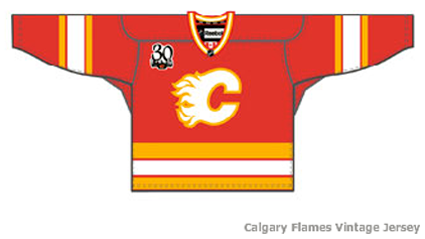

It just makes too much sense to us here at Third String Goalie to use a hot color to represent a flame, which is why we get a headache from how wrong the black "C" is that the Flames have been wearing for waaaaaaaaay too long now, which is why we endorse the Calgary Flames new "throwback" alternate with the white Flaming "C".

The jersey features a white Flaming "C" logo with yellow trim on a red jersey with yellow and white stripes on the arms and waist.
It also sports a 30th Anniversary patch on the right chest.
"All of the fans, they say 'What are you doing? Couldn't you just once think about bringing back that great and that venerable jersey?' Of course we not only thought about it, that's what we're going to do," Flames President and CEO Ken King said."I'm going to feel kind of nostalgic when I see that sweater, because that was our first sweater," co-owner Harley Hotchkiss said. "Sometimes I feel a bit lonely because I'm really the only one remaining of that original ownership group. I get some comfort of course from Jim Peplinski who's been around here for 30 years and can hold my hand whenever I'm feeling sorry for myself.""We think it's important to honor our history, and we think it's as important to focus going forward," King said.
The jerseys will be worn a mere five times this season, once each against the Flames other five Canadian opponents, Edmonton, Vancouver, Montreal, Toronto and Ottawa.
We here at Third String Goalie fully support the Flames new alternate jersey, perhaps for reasons you may not have considered.
The reason we fully endorse the Flames return to the white "C" is not for wholly nostalgic reasons, but because it's so right that a red Flames jersey have a white "C" on it rather than a black "C".

Take a moment to look at the brightest spots of the fire, which are the hottest spots, pictured above. They are white, which is a hot color, as are red, orange and yellow. Now look at the areas of the picture which are NOT on fire. They are the coldest parts of the photo. They are the black areas. Black is a cold, dead, lifeless color and it makes no sense to use black for a flaming object, such as the Flaming "C" logo pictured below.


Here is the original red jersey's finest moment, capturing the 1989 Stanley Cup.
Labels:
Calgary Flames
Subscribe to:
Comments (Atom)

